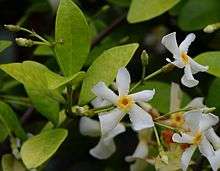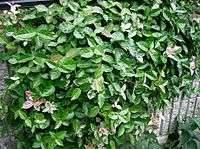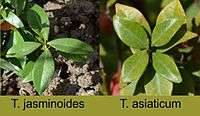Trachelospermum asiaticum
Trachelospermum asiaticum (common name Asiatic jasmine) is a species of plant in the family Apocynaceae, native to Asia.[2] It has gained the Royal Horticultural Society's Award of Garden Merit.[3]
| Trachelospermum asiaticum | |
|---|---|
 | |
| "Windmill"-shaped flowers | |
| Scientific classification | |
| Kingdom: | Plantae |
| Clade: | Tracheophytes |
| Clade: | Angiosperms |
| Clade: | Eudicots |
| Clade: | Asterids |
| Order: | Gentianales |
| Family: | Apocynaceae |
| Genus: | Trachelospermum |
| Species: | T. asiaticum |
| Binomial name | |
| Trachelospermum asiaticum | |
Etymology
Trachelospermum is composed of Greek trachelos τραχελος 'col', and sperma σπερμα 'seed, seed', referring to the shape of the seeds, elongated-narrowed at the apex and terminated by an egret. The specific epithet asiaticum indicates "from Asia".
It was first described by Philipp Franz von Siebold and Joseph Gerhard Zuccarini in 1846. Bavarian physician and naturalist Siebold was able to set foot in Japan between 1823 and 1829, at a time when China and Japan. Back in Germany with his collections, he was assisted by Zuccarini, professor of botany at the University of Munich to describe under the name of Malouetia asiatica (1846).
Description
Growing to 6 m (20 ft) tall, it is a woody, evergreen climber with glossy, leathery leaves and strongly scented cream-coloured flowers in summer.[4] They exude a milky white latex. Leaves are simple and opposite, persistent, borne by a petiole 2-10 mm, with an elliptic limb , narrowly ovate, 2-10 x 1-5 cm, membranous. Glossy green leaves have a brown-orange tinge stained reddish during the winter. The hardiest Trachelospermum species, this plant can be grown in temperate areas against a sheltered wall or fence. It has been known to spread rapidly, and can take over large sums of area.[5]
The white or cream flowers have a yellow heart and exhale a scent of jasmine. They are collected in terminal or axillary cymes. The five sepals are contiguous to the tube of the corolla and carry 10 basal glands. The hypocrateriform corolla consists of a tube 6-10mm long, with an enlarged throat, and five obovate lobes, as long as the tube. The stamens are inserted into the throat of the corolla tube. The anthers are exerted (protrude outside the tube, unlike T. jasminoides). The hairless ovary consists of two carpels. Flowering takes place from late spring to summer.
The fruit consists of two linear follicles, 10-30 by 0.3-0.5 cm. The seeds are oblong with at one end a 3.5 cm egret.[6]
Range


Trachelospermum asiaticum is native to China, India, Japan, Korea, Indo-China and Malaysia. It grows in mountain forests and scrub, often attached to trees.
Cultivation
Quite similar to the false jasmine Trachelospermum jasminoides, T. asiaticum produces flowers with a slightly smaller yellow heart (or cream). It has faster growth in the early years and is a bit more rustic. Trachelospermum asiaticum provides an ornamental liana, to be climbed on a trellis along a wall, in semi-shade or sunny exposure, and giving a very fragrant bloom. It can withstand brief frosts of -15°C . It is grown in tanks or in the ground in mild climates.[7]
Chemical composition
Many flavonoids were extracted from the leaves of Trachelospermum asiaticum var. intermedium: apigenin 7-Oglucoside, luteolin, luteolin-4, rhoifolin, lonicerine, kaempferol 3-O-rhamnoside, quercitrin, and phenolic compounds such as: lignan and chlorogenic acid.[8]
Of triterpenes oleanolic type were also detected: the acid 2α, 3β, 19α, 23,24-pentahydroxyoléan-12-en-28-oic acid or trachélospérogénine E 8 .
The plant is used in Korea in traditional medicine to treat rheumatism, abscesses and ulcers.
References
- "International Plant Names Index". Retrieved 24 April 2013.
- "Trachelospermum asiaticum (Siebold & Zucc.) Nakai". Plants of the World Online. Kew Science. Retrieved 17 June 2020.
- "RHS Plant Selector - Trachelospermum asiaticum". Retrieved 6 June 2013.
- RHS A-Z encyclopedia of garden plants. United Kingdom: Dorling Kindersley. 2008. p. 1136. ISBN 1405332964.
- Mori Tamezô, An Enumeration of Plants Hitherto Known From Corea 293. 1922
- Fumiko A and Tatsuo Y , " Glycosides of 19α-Hydroxyoleanan-type triterpenoids from Trachelospermum asiaticum (Trachelospermum IV) ", Chem Pharm Bull , vol. 35, n o 5,1987
- Christophe Wiart , Ethnopharmacology of medicinal plants Asia and the Pacific , Totowa, NJ, Humana Press,2006 ( ISBN 1588297489 , 9781588297488 , 9781597451604 and 1597451606
- Eri Shimizu Shinzo Hosoi , " Main phenolic compounds from the flower of Trachelospermum asiaticum var. intermedium (Apocynaceae). " Journal of natural medicines , vol. 62, n o 3,2008, p. 354-5